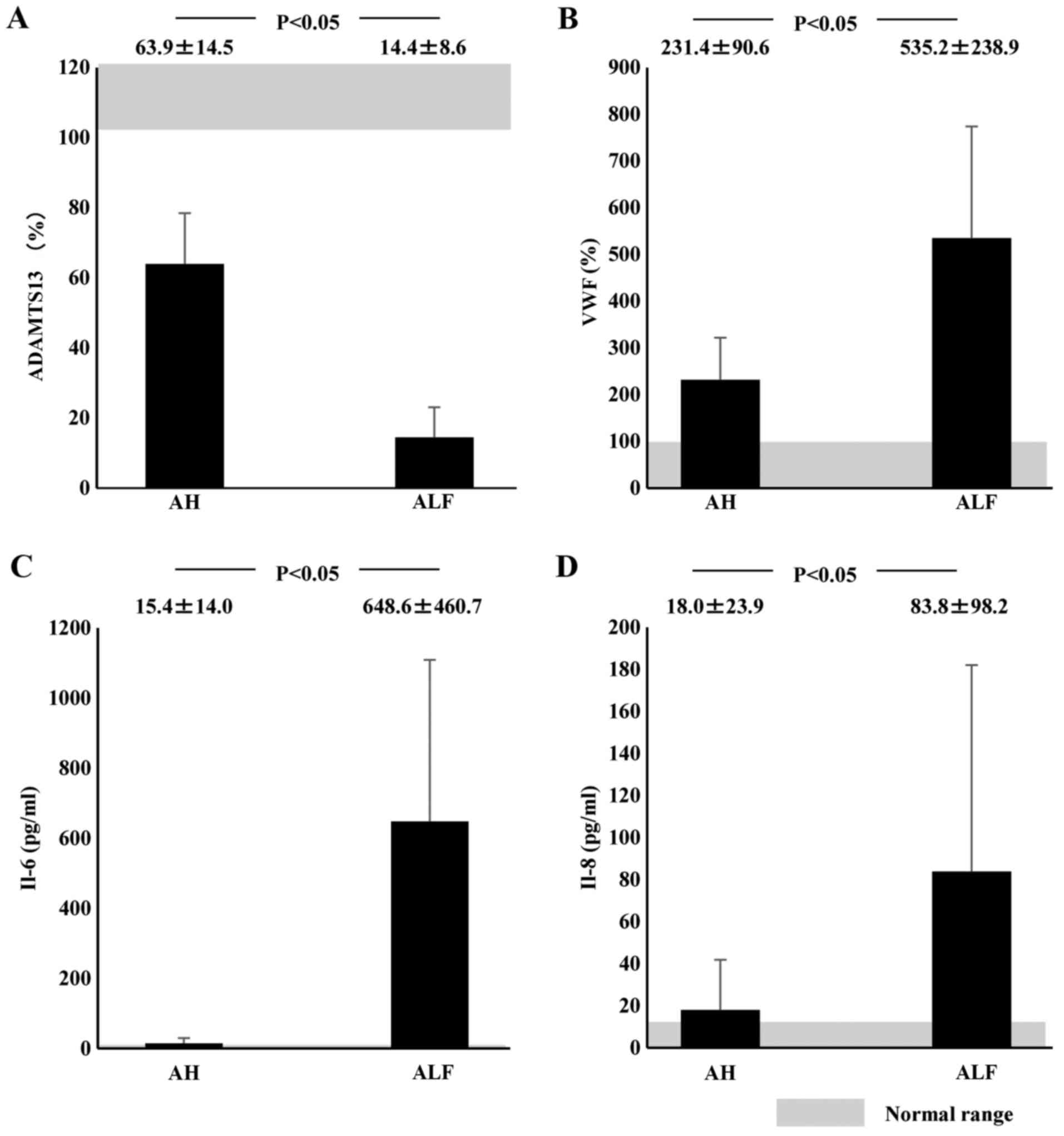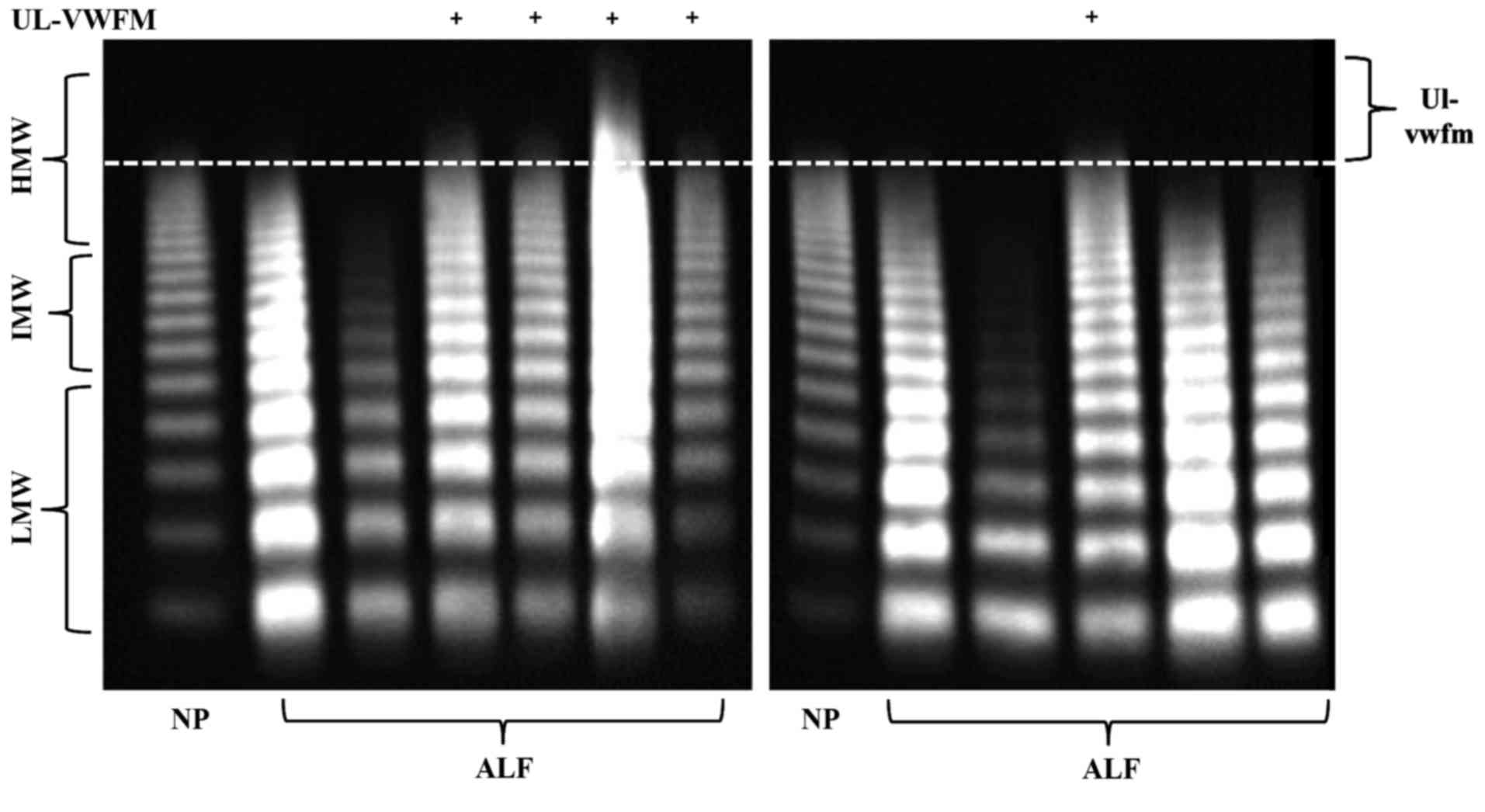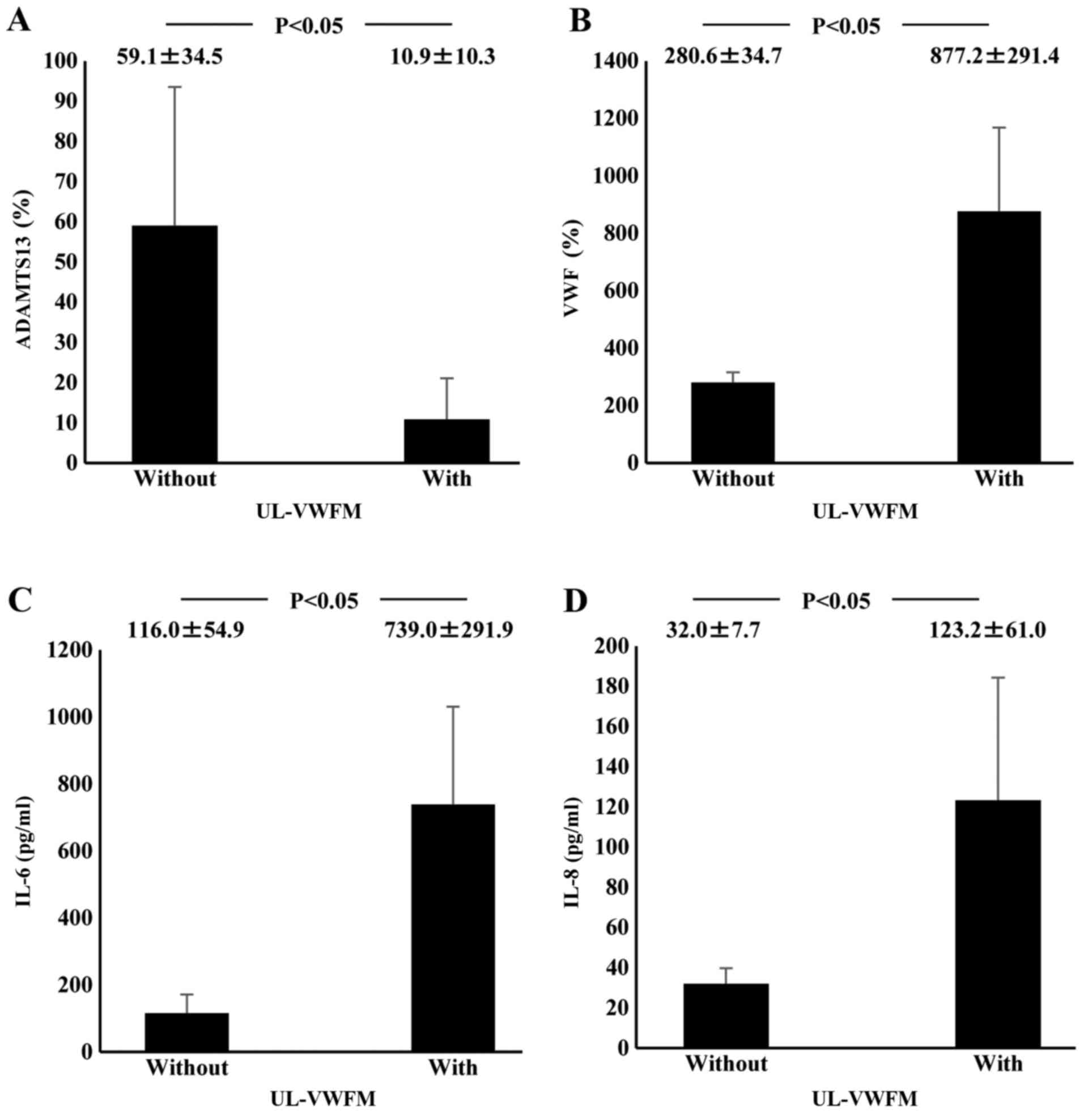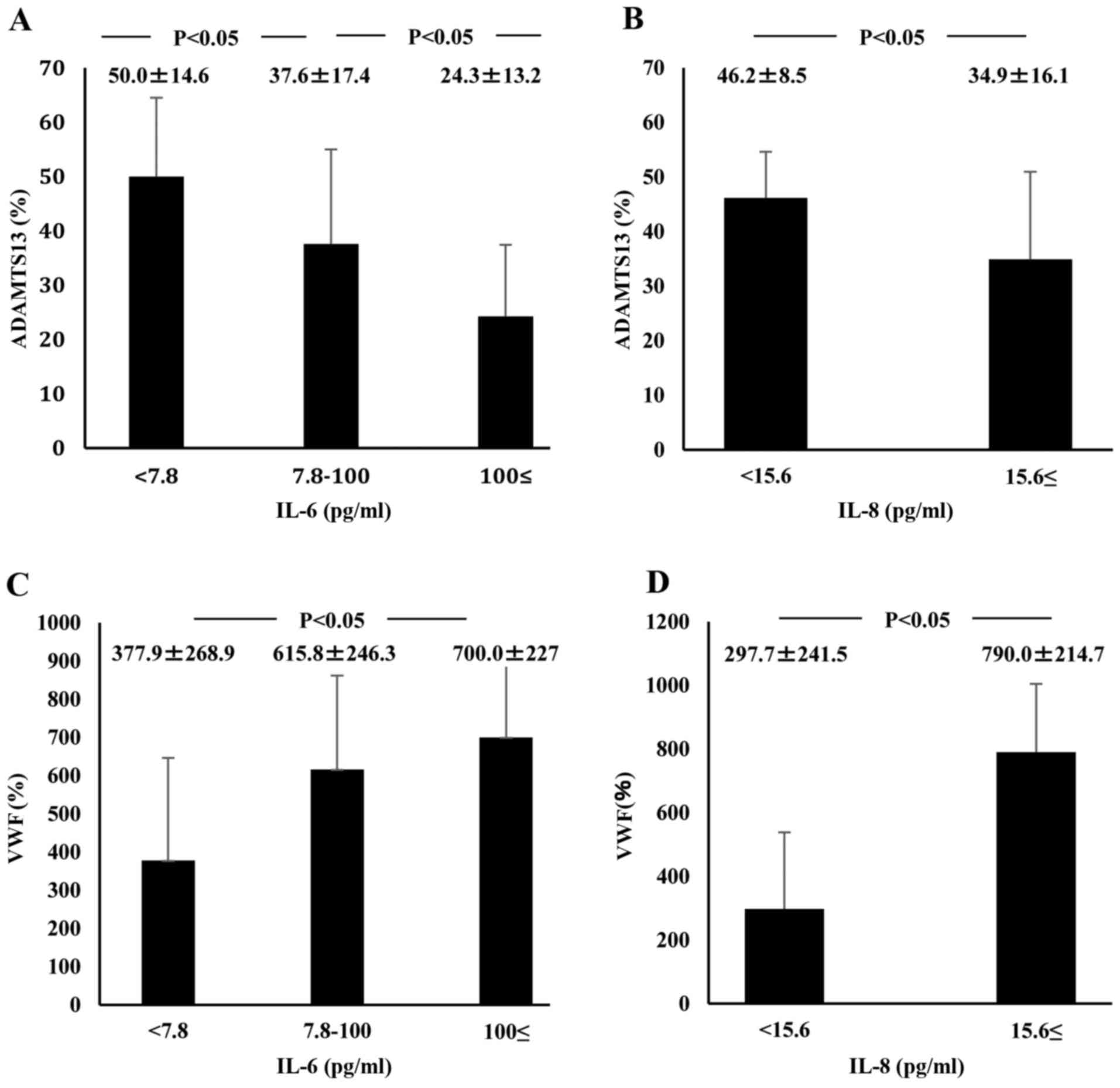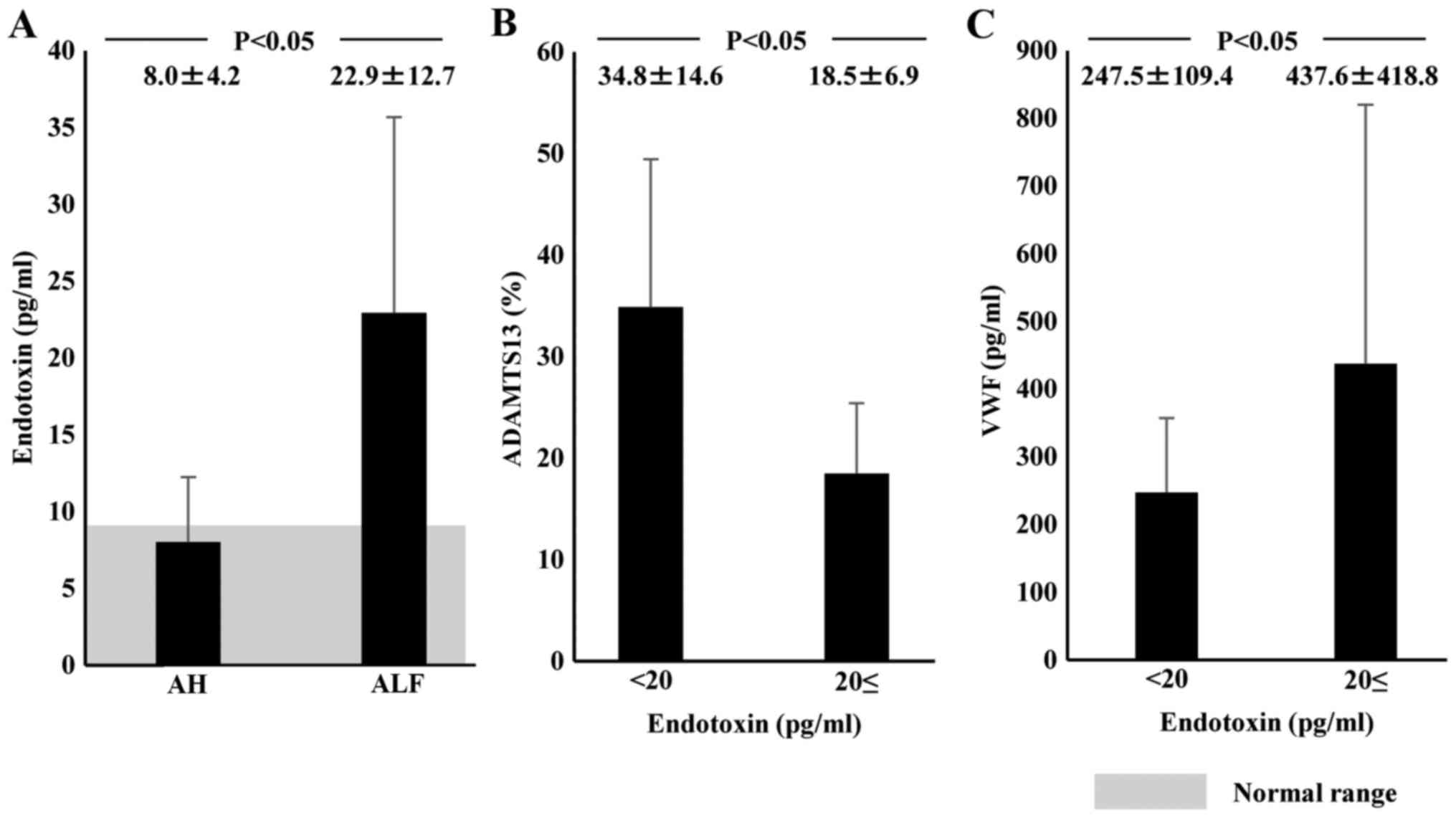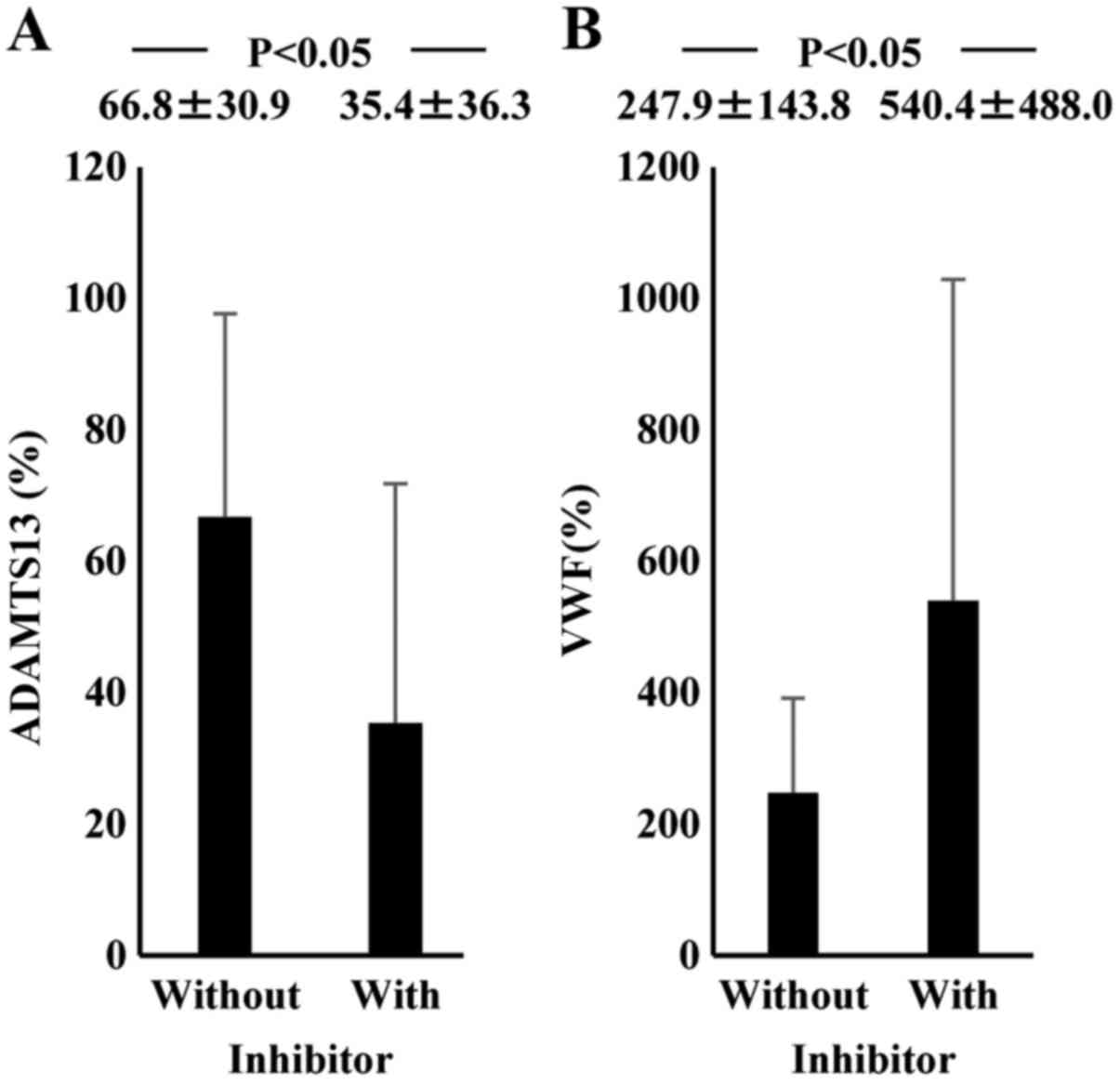|
1
|
Zheng X, Chung D, Takayama TK, Majerus EM,
Sadler JE and Fujikawa K: Structure of von Willebrand
factor-cleaving protease (ADAMTS13), a metalloprotease involved in
thrombotic thrombocytopenic purpura. J Biol Chem. 276:41059–41063.
2001. View Article : Google Scholar : PubMed/NCBI
|
|
2
|
Uemura M, Tatsumi K, Matsumoto M, Fujimoto
M, Matsuyama T, Ishikawa M, Iwamoto TA, Mori T, Wanaka A, Fukui H
and Fujimura Y: Localization of ADAMTS13 to the stellate cells of
human liver. Blood. 106:922–924. 2005. View Article : Google Scholar : PubMed/NCBI
|
|
3
|
Moake JL, Turner NA, Stathopoulos NA,
Nolasco LH and Hellums JD: Involvement of large plasma von
Willebrand factor (vWF) multimers and unusually large vWF forms
derived from endothelial cells in shear stress-induced platelet
aggregation. J Clin Invest. 78:1456–1461. 1986. View Article : Google Scholar : PubMed/NCBI
|
|
4
|
Levy GG, Nichols WC, Lian EC, Foroud T,
McClintick JN, McGee BM, Yang AY, Siemieniak DR, Stark KR, Gruppo
R, et al: Mutations in a member of the ADAMTS gene family cause
thrombotic thrombocytopenic purpura. Nature. 413:488–494. 2001.
View Article : Google Scholar : PubMed/NCBI
|
|
5
|
Furlan M, Robles R, Galbusera M, Remuzzi
G, Kyrle PA, Brenner B, Krause M, Scharrer I, Aumann V, Mittler U,
et al: von Willebrand factor-cleaving protease in thrombotic
thrombocytopenic purpura and the hemolytic-uremic syndrome. N Engl
J Med. 339:1578–1584. 1998. View Article : Google Scholar : PubMed/NCBI
|
|
6
|
Griffin D, Al-Nouri ZL, Muthurajah D, Ross
JR, Ballard RB, Terrell DR, Vesely SK, George JN and Marques MB:
First symptoms in patients with thrombotic thrombocytopenic
purpura: What are they and when do they occur? Transfusion.
53:235–237. 2013. View Article : Google Scholar : PubMed/NCBI
|
|
7
|
Ishikawa M, Uemura M, Matsuyama T,
Matsumoto M, Ishizashi H, Kato S, Morioka C, Fujimoto M, Kojima H,
Yoshiji H, et al: Potential role of enhanced cytokinemia and plasma
inhibitor on the decreased activity of plasma ADAMTS13 in patients
with alcoholic hepatitis: relationship to endotoxemia. Alcohol Clin
Exp Res. 34 Suppl 1:25–33. 2010. View Article : Google Scholar
|
|
8
|
Uemura M, Fujimura Y, Matsumoto M,
Ishizashi H, Kato S, Matsuyama T, Isonishi A, Ishikawa M, Yagita M,
Morioka C, et al: Comprehensive analysis of ADAMTS13 in patients
with liver cirrhosis. Thromb Haemost. 99:1019–1029. 2008.PubMed/NCBI
|
|
9
|
Hugenholtz GC, Adelmeijer J, Meijers JC,
Porte RJ, Stravitz RT and Lisman T: An unbalance between von
Willebrand factor and ADAMTS13 in acute liver failure: Implications
for hemostasis and clinical outcome. Hepatology. 58:752–761. 2013.
View Article : Google Scholar : PubMed/NCBI
|
|
10
|
Fukui H: Relation of endotoxin, endotoxin
binding proteins and macrophages to severe alcoholic liver injury
and multiple organ failure. Alcohol Clin Exp Res. 29:172S–179S.
2005. View Article : Google Scholar : PubMed/NCBI
|
|
11
|
Nolan JP: The role of intestinal endotoxin
in liver injury: A long and evolving history. Hepatology.
52:1829–1835. 2010. View Article : Google Scholar : PubMed/NCBI
|
|
12
|
Cao WJ, Niiya M, Zheng XW, Shang DZ and
Zheng XL: Inflammatory cytokines inhibit ADAMTS13 synthesis in
hepatic stellate cells and endothelial cells. J Thromb Haemost.
6:1233–1235. 2008. View Article : Google Scholar : PubMed/NCBI
|
|
13
|
Bernardo A, Ball C, Nolasco L, Moake JF
and Dong JF: Effects of inflammatory cytokines on the release and
cleavage of the endothelial cell-derived ultralarge von Willebrand
factor multimers under flow. Blood. 104:100–106. 2004. View Article : Google Scholar : PubMed/NCBI
|
|
14
|
Bockmeyer CL, Claus RA, Budde U, Kentouche
K, Schneppenheim R, Lösche W, Reinhart K and Brunkhorst FM:
Inflammation-associated ADAMTS13 deficiency promotes formation of
ultra-large von Willebrand factor. Haematologica. 93:137–140. 2008.
View Article : Google Scholar : PubMed/NCBI
|
|
15
|
Mochida S, Nakayama N, Ido A, Takikawa Y,
Yokosuka O, Sakaida I, Moriwaki H, Genda T and Takikawa H: Revised
criteria for classification of the etiologies of acute liver
failure and late-onset hepatic failure in Japan: A report by the
Intractable Hepato-biliary Diseases Study Group of Japan in 2015.
Hepatol Res. 46:369–371. 2016. View Article : Google Scholar : PubMed/NCBI
|
|
16
|
Matsumoto M, Kawa K, Uemura M, Kato S,
Ishizashi H, Isonishi A, Yagi H, Park YD, Takeshima Y, Kosaka Y, et
al: Prophylactic fresh frozen plasma may prevent development of
hepatic VOD after stem cell transplantation via ADAMTS13-mediated
restoration of von Willebrand factor plasma levels. Bone Marrow
Transplant. 40:251–259. 2007. View Article : Google Scholar : PubMed/NCBI
|
|
17
|
Koyama N, Matsumoto M, Tamaki S, Yoshikawa
M, Fujimura Y and Kimura H: Reduced larger von Willebrand factor
multimers at dawn in OSA plasmas reflect severity of apnoeic
episodes. Eur Respir J. 40:657–664. 2012. View Article : Google Scholar : PubMed/NCBI
|
|
18
|
Kasper CK, Aledort L, Aronson D, Counts R,
Edson JR, van Eys J, Fratantoni J, Green D, Hampton J, Hilgartner
M, et al: Proceedings: A more uniform measurement of factor VIII
inhibitors. Thromb Diath Haemorrh. 34:6121975.PubMed/NCBI
|
|
19
|
Fukui H, Brauner B, Bode JC and Bode C:
Plasma endotoxin concentrations in patients with alcoholic and
non-alcoholic liver disease: Reevaluation with an improved
chromogenic assay. J Hepatol. 12:162–169. 1991. View Article : Google Scholar : PubMed/NCBI
|
|
20
|
Kanda Y: Investigation of the freely
available easy-to-use software ‘EZR’ for medical statistics. Bone
Marrow Transplant. 48:452–458. 2013. View Article : Google Scholar : PubMed/NCBI
|
|
21
|
Shah N, de Oca M Montes, Jover-Cobos M,
Tanamoto K, Muroi M, Sugiyama K, Davies NA, Mookerjee RP, Dhar DK
and Jalan R: Role of toll-like receptor 4 in mediating multiorgan
dysfunction in mice with acetaminophen induced acute liver failure.
Liver Transpl. 19:751–761. 2013. View
Article : Google Scholar : PubMed/NCBI
|
|
22
|
Melgaço JG, Soriani FM, Sucupira PH,
Pinheiro LA, Vieira YR, de Oliveira JM, Lewis-Ximenez LL, Araújo
CC, Pacheco-Moreira LF, Menezes GB, et al: Changes in cellular
proliferation and plasma products are associated with liver
failure. World J Hepatol. 8:1370–1383. 2016. View Article : Google Scholar : PubMed/NCBI
|
|
23
|
Mookerjee RP, Dalton RN, Davies NA, Hodges
SJ, Turner C, Williams R and Jalan R: Inflammation is an important
determinant of levels of the endogenous nitric oxide synthase
inhibitor asymmetric dimethylarginine (ADMA) in acute liver
failure. Liver Transpl. 13:400–405. 2007. View Article : Google Scholar : PubMed/NCBI
|
|
24
|
Rolando N, Wade J, Davalos M, Wendon J,
Philpott-Howard J and Williams R: The systemic inflammatory
response syndrome in acute liver failure. Hepatology. 32:734–739.
2000. View Article : Google Scholar : PubMed/NCBI
|
|
25
|
Shinozaki K, Oda S, Abe R, Tateishi Y,
Yokoi T and Hirasawa H: Blood purification in fulminant hepatic
failure. Contrib Nephrol. 166:64–72. 2010. View Article : Google Scholar : PubMed/NCBI
|
|
26
|
Fujimoto M, Uemura M, Nakatani Y, Tsujita
S, Hoppo K, Tamagawa T, Kitano H, Kikukawa M, Ann T, Ishii Y, et
al: Plasma endotoxin and serum cytokine levels in patients with
alcoholic hepatitis: Relation to severity of liver disturbance.
Alcohol Clin Exp Res. 24 Suppl:48S–54S. 2000.PubMed/NCBI
|
|
27
|
Fukui H, Brauner B, Bode JC and Bode C:
Chromogenic endotoxin assay in plasma. Selection of plasma
pretreatment and production of standard curves. J Clin Chem Clin
Biochem. 27:941–946. 1989.PubMed/NCBI
|
|
28
|
Ono T, Mimuro J, Madoiwa S, Soejima K,
Kashiwakura Y, Ishiwata A, Takano K, Ohmori T and Sakata Y: Severe
secondary deficiency of von Willebrand factor-cleaving protease
(ADAMTS13) in patients with sepsis-induced disseminated
intravascular coagulation: Its correlation with development of
renal failure. Blood. 107:528–534. 2006. View Article : Google Scholar : PubMed/NCBI
|
|
29
|
Yagita M, Uemura M, Nakamura T, Kunitomi
A, Matsumoto M and Fujimura Y: Development of ADAMTS13 inhibitor in
a patient with hepatitis C virus-related liver cirrhosis causes
thrombotic thrombocytopenic purpura. J Hepatol. 42:420–421. 2005.
View Article : Google Scholar : PubMed/NCBI
|
|
30
|
Kitano K, Gibo Y, Kamijo A, Furuta K,
Oguchi S, Joshita S, Takahashi Y, Ishida F, Matsumoto M, Uemura M
and Fujimura Y: Thrombotic thrombocytopenic purpura associated with
pegylated-interferon alpha-2a by an ADAMTS13 inhibitor in a patient
with chronic hepatitis C. Haematologica. 91:ECR342006.PubMed/NCBI
|
|
31
|
Reiter RA, Varadi K, Turecek PL, Jilma B
and Knöbl P: Changes in ADAMTS13 (von-Willebrand-factor-cleaving
protease) activity after induced release of von Willebrand factor
during acute systemic inflammation. Thromb Haemost. 93:554–558.
2005.PubMed/NCBI
|



